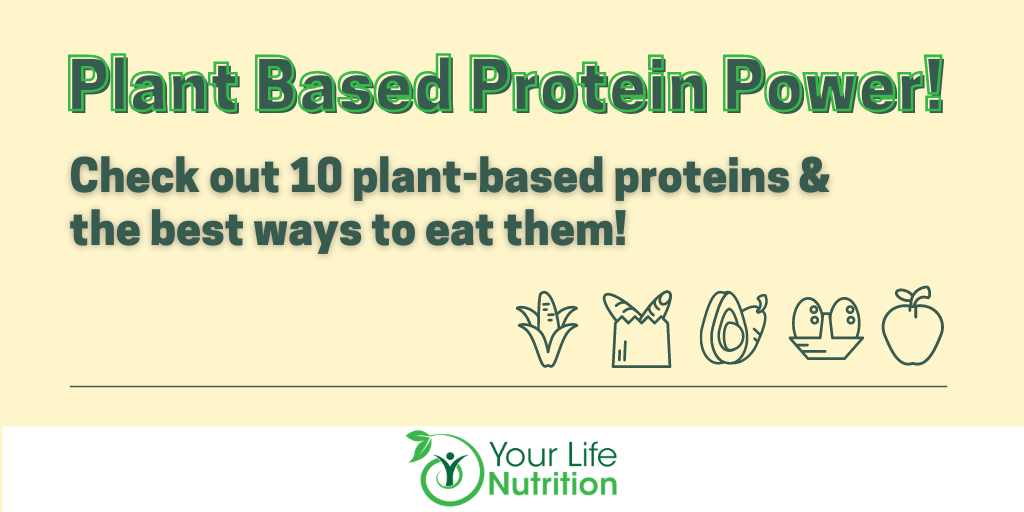Have you heard the hype about eating a plant-based diet? What’s all the craze about?
A plant-based diet is one that is mainly composed of foods from plant sources—vegetables, fruits, legumes, grains, etc. Eating plant-based can mean a lot of things. Veganism is one category of plant-based eating with no consumption of ANY animal products—no eggs, dairy, meat, or honey. Vegetarianism is another category of plant-based eating, which typically means no meat is consumed, but other animal products are.
You don’t need to completely change your eating patterns to incorporate more plant-based foods into your diet, however. Some people follow a “flexitarian” eating pattern, meaning that they mostly focus on plant-based foods but occasionally eat animal products and meats. Another pattern is “Meatless Mondays, where one does not eat meat on Mondays or one day of the week.
There are many benefits that come with incorporating more plant-based foods in your diet, namely lower cholesterol, lower saturated fat intake, and an increase in some vitamin and mineral intake. One of the biggest myths about plant-based eating is that it just isn’t possible to meet protein needs. Wrong!
Some plant-based protein options, such as pre-packaged and frozen protein alternatives, can be pricey. Things like frozen vegan chicken tenders, meatballs, and veggie burgers can take a toll on your wallet. Not to mention, a lot of those vegan protein alternatives are loaded with extra sodium, preservatives and fillers, which can make them not-so-healthy. That being said, there are MANY plant-based protein options that are inexpensive, easy to prepare, and are things you may already have in your fridge or pantry!
Here are ten awesome, affordable, and 100% plant-based protein options to incorporate into your diet and reach your goals!

1.Tofu/Tempeh
Firm tofu, often found in a refrigerated block, is essentially curdled soybean. Tempeh is very similar to tofu, except it is not processed as extensively and is more dense and textured.

Protein:
Tofu: 10g protein per ½ cup
Tempeh: 15g protein per ½ cup
How to Use It:
Tofu and tempeh can be incorporated into countless recipes, including stir fries, wraps, and tacos, and can be seasoned to any taste.
2. Seitan
Seitan is a plant-based protein made from wheat gluten.

Protein:
21g protein per ⅓ cup
How to Use It:
When it is seasoned, its consistency makes seitan a great substitute for beef in many dishes.
3 & 4. Chickpeas/Lentils
Chickpeas, or garbanzo beans, are small, firm beans that are so versatile and easy to prepare!
Lentils are small, firm legumes that can be found canned or dry. Cooked lentils are also a source of potassium and iron.

Protein:
Chickpeas: 7g protein per ½ cup
Lentils: 9g protein per ½ cup
How to Use It:
Often found in a can, chickpeas can be drained and eaten right away. Chickpeas can be incorporated into salads, roasted in the oven, or mashed and turned into hummus. Try this Mediterranean Chickpea Salad recipe!
When cooked, lentils soften and can be incorporated into soups, chili, stews, or rice.
5. Quinoa
Quinoa is protein-packed, round grain with many uses. Quinoa refers to the edible seeds of a flowering amaranth plant. Although it is a grain, quinoa contains all nine essential amino acids that your body needs, making it a complete protein.

Protein:
8g protein per 1 cup
How to Use It:
Quinoa can replace rice in many dishes, also making a great bed for roasted veggies, base for a grain bowl, or addition to a salad. For convenience, quinoa can also be found in ready-to-microwave, single-serve bowls.
6. Rice & Beans
Rice and beans are very easy to prepare and store. When paired together, rice and beans are also a complete protein, providing all the amino acids your body needs. Be sure to opt for brown rice, as brown rice contains more nutrients and fiber than other variations.

Protein:
7g protein per 1 cup
How to Use It:
Black beans and brown rice can be used in a tortilla or wrap, make a base for a burrito bowl, or used as a side dish.
7. Soy Milk
Soy milk, a plant-based milk made with soy beans, is a great alternative to dairy milk. Be sure to opt for unsweetened soy milk, as “original” and flavored versions contain added sugars. For example, one serving of Silk “Original” soy milk has 110 calories and 6 grams of sugar, whereas the “Unsweet” version has only 80 calories and 1 gram of sugar. Fortified, unsweetened soy milk is loaded with calcium, vitamin D, and vitamin B12, and has about the same protein content as dairy milk.

Protein:
7g protein per 1 cup
How to Use It:
Soy milk can replace dairy milk in combination with other foods or in any recipe! Soy milk is great in smoothies, with cereal, or added to coffee.
8. Nuts
Nuts can be incorporated into your diet in so many ways! A small amount of nuts contains a relatively large amount of protein.

Protein:
Peanuts: 7g protein per ¼ cup
Almonds: 6g protein per ¼ cup
Cashews: 5g protein per ¼ cup
How to Use It:
You can make a nut trail mix, pair nuts with a fruit or veggie as a balanced snack, or just eat a small handful.
9. Nut Butter
Nut butter is a versatile, protein-packed food to add at snack or meal time.

Protein:
Peanut Butter: 7g protein per 2 tablespoons
Almond Butter: 7g protein per 2 tablespoons
How to Use It:
Nut butters can be spread on whole-wheat bread, added to a smoothie, or serve as a dip for fruit and veggies. Our personal fave is Crazy Richard’s Peanut Butter & Almond Butter!
10. Hemp Seeds
Hemp seeds, which are small, brown seeds derived from the cannabis sativa plant, have many uses. Found in a bottle or bag, and sometimes in combination with chia and flax seeds, hemp seeds are a good source of omega-3 fatty acids and fiber.

Protein:
5g protein per 1 tablespoon
How to Use It:
Hemp seeds can be sprinkled on a salad or toast or added to a smoothie for a little protein boost.
These are just a few examples of plant-based proteins to incorporate into your diet. Try substituting these options here and there in your usual meals or snacks for some plant-based protein power!
Written by: Your Life Nutrition Intern – Madelyn Huzyak, junior at Bowling Green State University majoring in Dietetics





